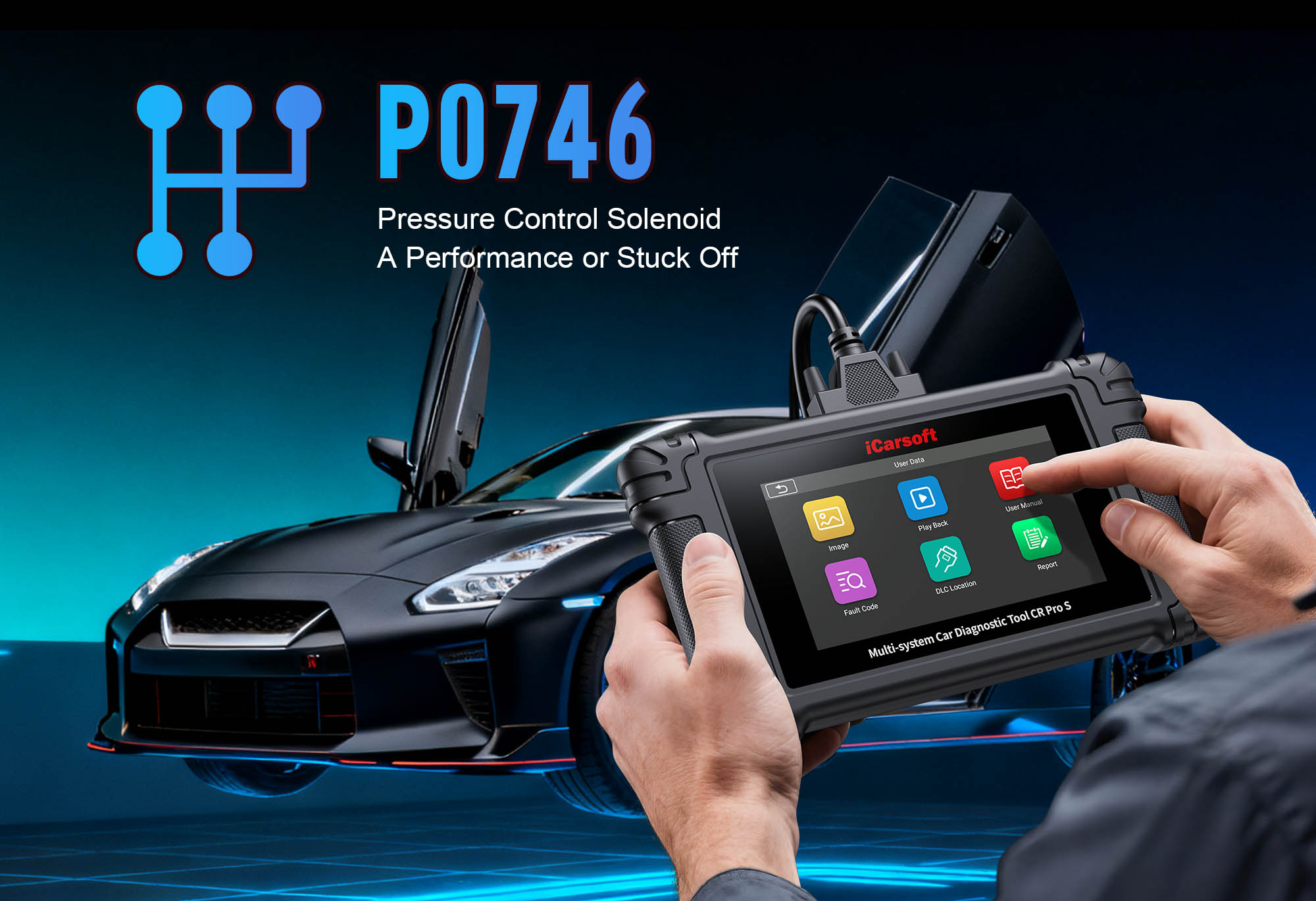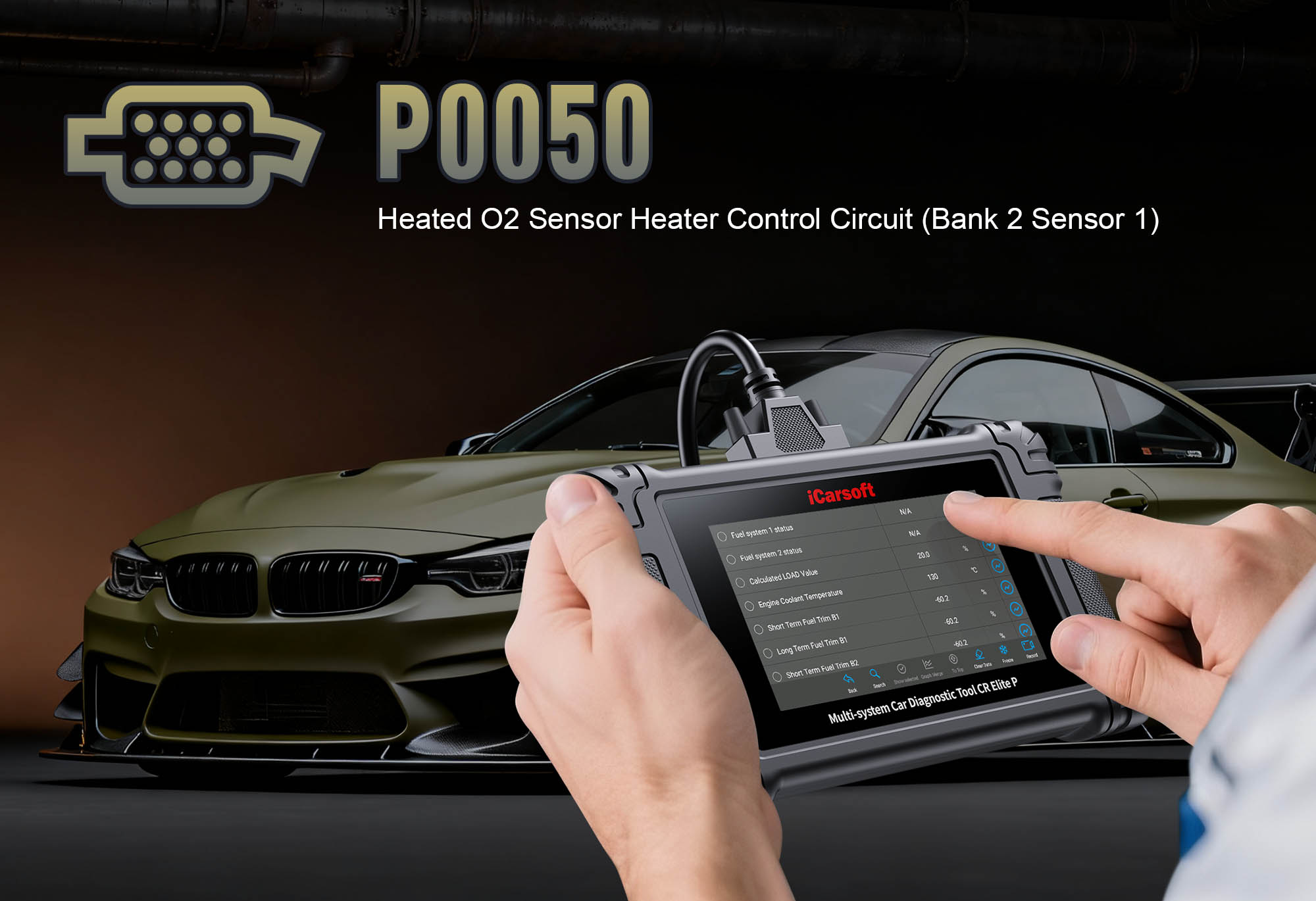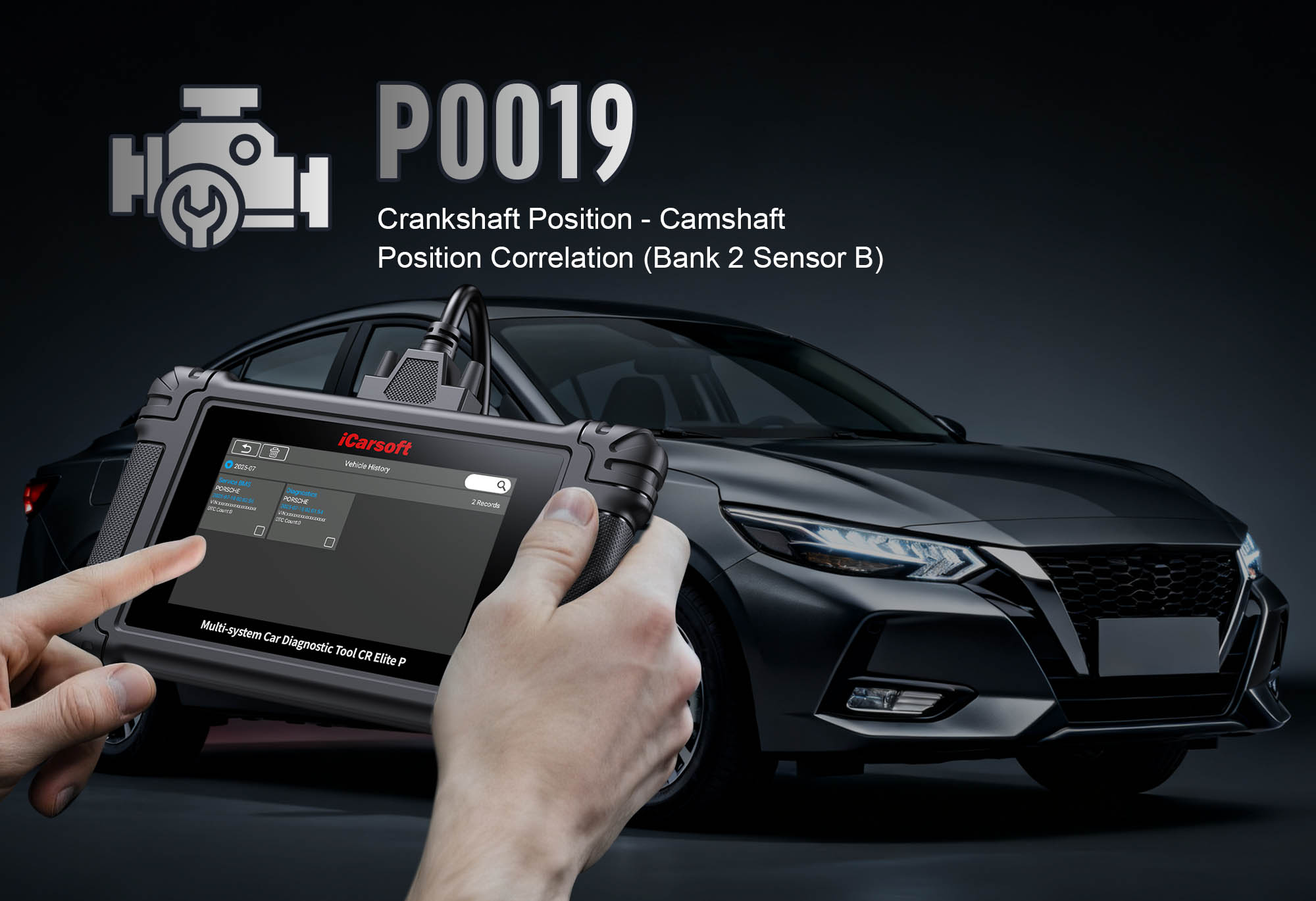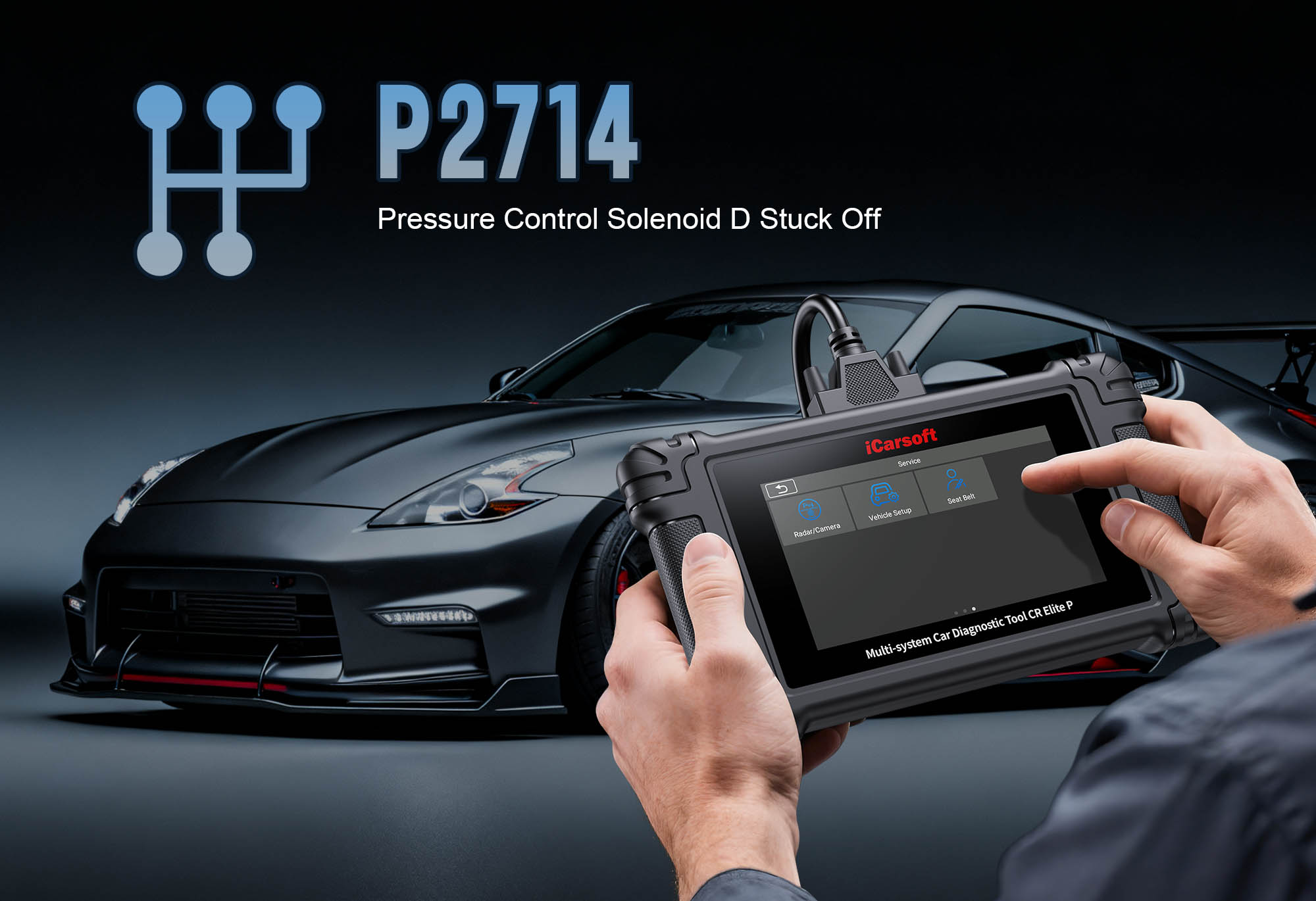Diagnose & Clear P0746 with iCarsoft CR Elite P: Fix Torque Converter Clutch Pressure Control Solenoid Issues
Diagnose & Clear P0746 with iCarsoft CR Elite P: Fix Torque Converter Clutch Pressure Control Solenoid Issues
If your check engine light turns on, you feel a "shudder" during highway speeds, or notice reduced fuel efficiency, a diagnostic scan will likely return P0746. This OBD-II code stands for "Torque Converter Clutch (TCC) Pressure Control Solenoid Circuit Performance" or "TCC Pressure Control Solenoid Stuck Closed"—a critical fault disrupting the transmission’s ability to lock the torque converter. The TCC eliminates slip between engine and transmission for better fuel economy; a faulty solenoid causes rough driving, overheating, and long-term transmission damage if ignored.
Basic scanners can’t test TCC pressure or verify circuit integrity, but the iCarsoft CR Elite P’s specialized transmission diagnostics solve this. Let’s walk through diagnosing and resolving P0746 with precision.
Understanding P0746: Causes & Key Symptoms
A malfunctioning TCC solenoid or circuit disrupts torque converter operation, with symptoms worsening over time:
Key Symptoms of P0746
-
Check Engine Light + Transmission Warning Light: CEL triggers for P0746; a "Transmission Fault" light signals TCM limp mode to prevent damage.
-
Torque Converter Shudder: Vibration at 40–60 mph—caused by TCC failing to lock, creating slip between engine and transmission.
-
Reduced Fuel Efficiency: Unlocked TCC raises cruising RPM (e.g., 2,500 vs. 1,800 RPM), increasing fuel use by 10–15%.
-
Rough Gear Shifts: TCM relies on TCC data for shift timing—faulty solenoids cause jolts when shifting to "Overdrive" or decelerating.
-
Transmission Overheating: Slip generates excess heat, triggering "Transmission Hot" warnings and fluid breakdown.
-
Limp Mode Activation: Severe issues limit speed to 30–40 mph and disable overdrive, protecting clutches and valves.
Common Causes of P0746
|
Cause
|
Description
|
|
Stuck Closed TCC Solenoid
|
Debris or wear (vehicles >90,000 miles) blocks the valve, preventing pressure flow to the TCC.
|
|
Faulty Solenoid Circuit
|
Frayed wires, corroded connectors, or blown fuses disrupt TCM signals to the solenoid.
|
|
Low/Contaminated Fluid
|
Insufficient fluid reduces pressure; dirty fluid (sludge) clogs the solenoid valve.
|
|
Clogged Valve Body
|
Debris in the valve body (houses the TCC solenoid) blocks pressure passages, stopping TCC engagement.
|
|
TCM Software Glitch
|
Outdated firmware (2017+ vehicles) misinterprets solenoid signals, triggering false P0746.
|
|
Failed TCM
|
Faulty TCM can’t send/process pressure commands (rare, common in 2015+ Ford/GM models).
|
Why iCarsoft CR Elite P Excels at Diagnosing P0746
The CR Elite P outperforms basic tools with TCC-specific diagnostic features:
Live TCC Pressure Monitoring
Tracks real-time hydraulic pressure (psi) to the solenoid, comparing to TCM target pressure (50–80 psi for engagement).
Bi-Directional Solenoid Activation
Manually opens/closes the TCC solenoid to test responsiveness—confirms stuck valves or functional issues.
Solenoid Circuit Tests
Checks for short/open circuits and low voltage, distinguishing electrical vs. mechanical faults.
AutoVIN Identify
Retrieves vehicle/transmission specs (e.g., Ford 10R80, Toyota U660E) for TCC-specific pressure/range data.
Global Vehicle Coverage
Works with 500+ models (gasoline/diesel/hybrid) and supports automatic/semi-automatic/DCT transmissions.
Lifelong Free Updates
Installs TCM firmware fixes (e.g., GM 2020+ TCC calibrations) to resolve false P0746 codes.
Step-by-Step: Diagnose P0746 with iCarsoft CR Elite P
-
1. Check Transmission Fluid Level & Condition
Start with the simplest fix—low/dirty fluid causes 35% of P0746 cases:
1. Fluid Level Check: - Park on level ground, idle 5–10 minutes (warms fluid for accurate reading).
- Locate dipstick via Component Location > Transmission > Dipstick or use electronic test (no-dipstick vehicles).
- Add correct fluid (e.g., Dexron VI) if below "Hot" mark (check Fluid Guide).
2. Fluid Condition Inspection: - Healthy fluid = bright red/pink, slight sweet smell.
- Dark brown/black fluid with particles = change fluid + filter immediately (sludge clogs solenoids).
-
2. Connect the CR Elite P & Confirm P0746
1. Plug into OBD-II port (use adaptors for OBDI vehicles like old Mercedes/BMW).
2. Select AutoVIN Identify to detect transmission type/TCM version.
3. Navigate to Transmission > Fault Codes to confirm P0746—check Code Details for specs (e.g., "Toyota U660E: Target Pressure 65 psi").
4. Resolve related codes (P0740/P0741 = TCC engagement faults) first.
-
3. Locate the TCC Pressure Control Solenoid
Use the tool’s mapping to find the solenoid:
1. Navigate to Component Location > Transmission > TCC Pressure Control Solenoid.
2. Note key details from the diagram:
- Position: Internal (valve body, needs pan removal) or external (transmission case, easy access).
- Wiring: 2 wires (power = red, signal = blue) to TCM.
- Connector: Weather-sealed (prone to corrosion in underbody mounts).
-
4. Test the TCC Solenoid Circuit (Electrical Check)
Rule out wiring issues:
1. Turn off engine, disconnect the solenoid connector.
2. Power Wire Test: - Multimeter (DC Voltage) on power wire + ground—12V/5V (ignition "ON") = normal; 0V = blown fuse/broken wire.
3. Signal Wire Test: - Multimeter on signal wire + ground—0.5–1V fluctuation = normal; no fluctuation = open circuit/TCM fault.
4. Ground Test: - Multimeter (Ohms) on ground wire + chassis—<1 ohm = normal; >5 ohms = clean/replace ground strap.
-
5. Test the TCC Solenoid (Mechanical Check)
Verify solenoid health:
1. Resistance Test: - Multimeter (Ohms) across solenoid pins—10–30 ohms = normal; 0/infinite = replace solenoid.
2. Valve Blockage Check (external solenoids): - Remove solenoid (use Torque Guide), clean port with contact cleaner.
- Blow compressed air through port—blockages = clear or replace solenoid.
-
6. Monitor Live TCC Data & Pressure
Real-time data reveals engagement issues:
1. Warm engine, accelerate to 40 mph (TCC lock speed).
2. Navigate to Transmission > Live Data > TCC System and monitor:
- Engagement Status: "Locked" at 40+ mph = normal; "Unlocked" = fault.
- Pressure: Actual vs. target (match within 5 psi = normal).
- Duty Cycle: 30–70% during engagement = normal; 0% = TCM signal issue.
-
7. Perform Bi-Directional TCC Solenoid Activation
Confirm solenoid responsiveness:
1. Stationary (parking brake on), engine idle.
2. Navigate to Special Functions > Transmission > TCC Solenoid Activation.
3. Adjust duty cycle (25% → 75%):
- Working solenoid = "click" + pressure increase (10–20 psi).
- Stuck solenoid = no click/pressure change—replace.
-
8. Update TCM Firmware (If Solenoid/Circuit Are Good)
Fix software glitches:
1. Connect to Wi-Fi via System > Wi-Fi Settings.
2. Go to System > Update Manager > TCM Firmware.
3. Install latest update (e.g., "Ford F-150 2018–2022: TCC Pressure Calibration").
4. Clear P0746 and restart engine.
-
9. Repair & Clear P0746
Fix root cause:
1. Address issues:
- Faulty Solenoid: Replace with OEM part (use Part Lookup, e.g., GM 24235296).
- Circuit Fault: Repair wires/connectors.
- Fluid/Valve Body: Change fluid or flush valve body.
- TCM Fault: Reprogram via dealer.
2. Clear code via Transmission > Fault Codes > Clear Codes.
-
10. Validate the Repair
Ensure TCC functionality:
1. Test drive 30–40 minutes (highway + stop-and-go):
- No shudder at 40–60 mph; smooth TCC lock/unlock.
- Improved fuel efficiency (check Fuel Economy Tracker).
2. Post-drive scan: Use Transmission System Scan after 100 miles.
3. (Optional) Run I/M Readiness Test for emissions compliance.
Preventing P0746 Recurrence
Use the CR Elite P to maintain TCC health:
-
Regular Fluid Changes: Schedule every 60,000–80,000 miles (use Service Reminder).
-
Solenoid Inspection: Annual TCC Solenoid Check—clean connectors to prevent corrosion.
-
Avoid Short Trips: Use Drive Time Tracker—short drives (<10 mins) cause sludge.
-
TCM Updates: Enable auto-updates to install fixes promptly.
Conclusion
P0746’s TCC solenoid fault disrupts smooth driving and threatens transmission life—but the iCarsoft CR Elite P simplifies diagnosis with live pressure tracking, bi-directional testing, and circuit checks. Whether replacing a faulty solenoid, fixing wiring, or updating firmware, this tool ensures you address the root cause, not just the symptom—saving time and avoiding costly transmission repairs.
For DIYers and professionals alike, the CR Elite P’s global coverage, intuitive touchscreen, and lifelong free updates make it the ideal tool for resolving P0746. Restore smooth TCC operation, improve fuel efficiency, and protect your transmission—all with one professional-grade diagnostic tool.
FAQs About P0746 Code
Q: Can I drive with P0746?
A: Short distances are okay, but prolonged driving causes overheating and clutch wear. Stop if you feel shudder or see overheating warnings.
Q: How much does it cost to fix P0746?
A: $80–$200 for a TCC solenoid; $100–$300 for fluid/filter; $500–$1,200 for valve body repair; $800–$2,000 for TCM fixes. The CR Elite P saves by avoiding unnecessary repairs.
Q: Why does P0746 return after replacing the solenoid?
A: Likely unresolved issues—clogged valve body, faulty wiring, or outdated TCM firmware. Use the CR Elite P to retest pressure and circuit integrity.
Q: What’s the difference between P0746 and P0740?
A: P0746 = TCC pressure control solenoid issue; P0740 = general TCC system malfunction (e.g., engagement failure). The CR Elite P distinguishes them via pressure and solenoid tests.





